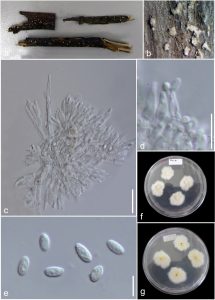Clonostachys byssicola Schroers, Stud. Mycol. 46: 80 (2001)
Index Fungorum number: IF 485119
Associated on a dead stem of Chromolaena odorata. Asexual morph: Sporodochia pale yellow or pale orange, appearing as dome-shaped masses on the host. Conidiophores dimorphic. Primary conidiophores 3–5.2 μm wide at base, septate, verticillately branched, rare, forming towards the margin, main stipe short, hyaline, smooth-walled. Phialides 15.3–38 μm (x̅ = 28.2 μm, n = 6) long, 1.8–3.3 μm (x̅ = 2.2 μm, n = 8) wide at base, in whorls of 2–4, straight, cylindrical, slightly tapering towards the tip, with periclinal thickening at their apex, collarette lacking or minute. Secondary conidiophores bi- to quinquies-verticillate, densely aggregated, formed in sporodochia on the host surface, septate, stipes short. Phialides in loose whorls of 3–5, straight to slightly curved, narrowly flask-shaped or cylindrical, tapering in the upper part, with a periclinal thickening at the apex, without a visible collarette, 8–15.6 (x̅ = 14.1 μm, n = 15) μm long, 1.5–3.1 μm (x̅ = 2.2 μm, n = 15) wide at base, intercalary phialides absent. Conidia 3.2–6 × 2–3.7 μm (x̅ = 4.9 – 3 μm, n = 35), ovoidal to subglobose, minutely curved, broadly rounded distally, with a laterally displaced hilum, hyaline, smooth-walled. Sexual morph: see Schroers (2002).
Material examined – Thailand, Chiang Mai Province, on a dead stem of Chromolaena odorata (Asteraceae), 2 February 2017, R.H. Perera, BN4 (MFLU 18-2729), living culture MFLUCC 17–2033.
GenBank numbers – ITS: MN597463, LSU: MT940528, ACL1: MN599047, TEF1-α: MN599044.
Known distribution (based on molecular data) – China, New Zealand, Venezuela (Taylor & Hyde 2003), Thailand (this study)
Known hosts (based on molecular data) – Archontophoenix species, Castanopsis carlesii, Rhopalostylis sp. (Taylor & Hyde 2003), Chromolaena odorata (this study)
Notes – The new isolate MFLUCC 17-2033 grouped with the ex-isotype of Clonostachys byssicola (CBS 364.78) with high statistical support (100% MLBT, 1.00 MBPP). Our collection resembles C. byssicola in having similar conidiomatal morphology and conidiophore and conidia dimensions (Schroers 2002). Hence, we identify our collection as C. byssicola.

Clonostachys byssicola (MFLU 18-2729, a new host record) a Herbarium material. b Sporodochia on the host. c Primary and secondary conidiophores. d Phialides with conidia. e Conidia. f, g Colony on PDA. Scale bars: c = 20 μm, d = 10 μm, e = 5 μm.
